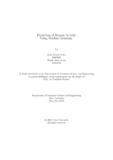Prediction of human activity using machine learning
Abstract
Involving machine learning in recognizing human activities is a widely discussed
topic of this era. It has a noticeable growth of interest for implementing a wide
range of applications such as health monitoring, indoor movements, navigation and
location-based services. The process is implemented gradually through several methods obtaining better accuracy than before. The data of human activities can be
collected by wifi module, bioharness or wearable device which can be waist, wrist
or thighs mounted. The purpose of our research is predicting human activities by
classifying sequences of remotely recorded data of well-defined human movements
using responsive sensors. The data are collected by a waist mounted device which
contains mobile phone sensors (e.g. accelerometer and gyroscope) for observing
human activities of different aged people. The observed data are modeled using machine learning and neural network. Here we have used machine learning algorithms
which are Support Vector Machine (SVM), K Nearest Neighbour (KNN), Linear
Regression, Logistic Regression, Decision Tree, Naive Bayes Classifier and Random
Forest Classifier. Moreover, we have also used artificial recurrent neural network
(RNN) architecture- Long Short-Term Memory algorithm and Multi Layer Perceptron (MLP) algorithm. Modeling the data using various algorithms and obtaining
results accurately are not convenient, because human motions recorded through
wearable sensors have variations and complexity. For overcoming these problems we
have used four dimension reduction techniques e.g. Principal Component Analysis
(PCA), Singular Value Decomposition (SVD), Linear Discriminant Analysis (LDA)
and Independent Component Analysis (ICA) for achieving more accurate activity
prediction performance with less complex and faster computations.

